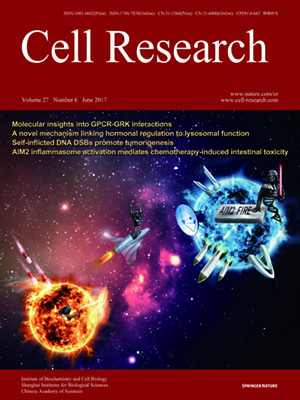
Volume 27, No 6, Jun 2017
ISSN: 1001-0602
EISSN: 1748-7838 2018
impact factor 17.848*
(Clarivate Analytics, 2019)
Volume 27 Issue 6, June 2017: 728-747 | Open Access
RESEARCH HIGHLIGHTS
Molecular assembly of rhodopsin with G protein-coupled receptor kinases
Yuanzheng He1, Xiang Gao1, Devrishi Goswami2,7, Li Hou3, Kuntal Pal1, Yanting Yin1,3, Gongpu Zhao4, Oliver P Ernst5,6, Patrick Griffin2, Karsten Melcher1 and H Eric Xu1,3
1Laboratory of Structural Sciences, Center for Structural Biology and Drug Discovery, Van Andel Research Institute, Grand Rapids, MI 49503, USA
2Department of Molecular Therapeutics, The Scripps Research Institute, Scripps Florida, Jupiter, FL 33458, USA
3VARI-SIMM Center, Center for Structure and Function of Drug Targets, CAS-Key Laboratory of Receptor Research, Shanghai Institute of Materia Medica, Chinese Academy of Sciences, Shanghai 201203, China
4The Cryo-EM Core, Van Andel Research Institute, Grand Rapids, MI 49503, USA
5Department of Biochemistry, University of Toronto, Toronto, Ontario M5S 1A8, Canada
6Department of Molecular Genetics, University of Toronto, Toronto, Ontario M5S 1A8, Canada
7Current address: Amgen, Thousand Oaks, CA 91320, USA
Correspondence: Yuanzheng He, E-mail: ajian.he@vai.org; H Eric Xu,(eric.xu@vai.org)
G protein-coupled receptor kinases (GRKs) play pivotal roles in desensitizing GPCR signaling but little is known about how GRKs recognize and phosphorylate GPCRs due to the technical difficulties in detecting the highly dynamic GPCR/GRK interaction. By combining a genetic approach with multiple biochemical assays, we identified the key determinants for the assembly of the prototypical GPCR rhodopsin with its kinase GRK1. Our work reveals that the regulatory G-protein signaling homology (RH) domain of GRKs is the primary binding site to GPCRs and an active conformation of the GRK1 kinase domain is required for efficient interaction with rhodopsin. In addition, we provide a mechanistic solution for the longstanding puzzle about the gain-of-function Q41L mutation in GRK5. This mutation is in the RH domain and increases the capacity of the GRK mutant to interact with and to desensitize GPCRs. Finally we present the principal architecture of a rhodopsin/GRK complex through negative stain electron microscopy reconstruction. Together, these data define the key components for the rhodopsin/GRK1 interaction and provide a framework for understanding GRK-mediated desensitization of GPCRs.
10.1038/cr.2017.72
FULL TEXT | PDF
Browse 1951


